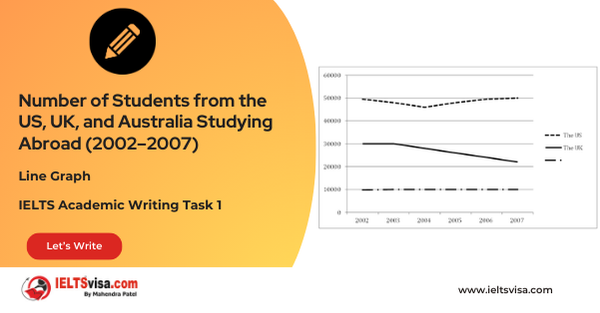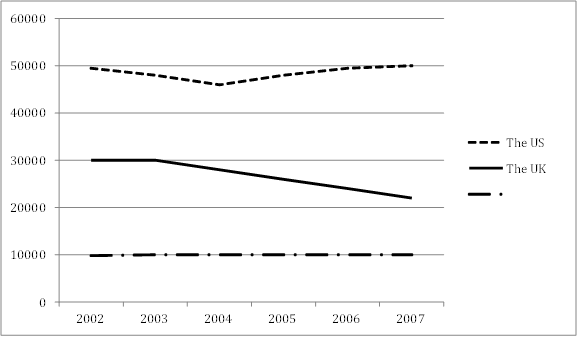Number of Students from the US, UK, and Australia Studying Abroad (2002–2007)
IELTS Academic Writing Task 1 - Line Graph
IELTS Writing Task 1 Question
The graph below shows the number of students from the US, the UK and Australia who studied in universities in other countries from 2002 to 2007. Summarise the information by selecting and reporting the main features and make comparisons where relevant.

Common Questions for the Line Graph
1. Graph Type: Line Graph
2. Title: Number of Students from the US, UK, and Australia Studying Abroad (2002–2007)
3. What are the units of measurement?: Number of students
4. Who: Students from the US, UK, and Australia studying in foreign universities
5. When: 2002 to 2007
6. Where: Abroad (other countries)
7. Topic: Trends in international student numbers from three countries
Comparison Showing and Trends Any change over time (such as an increase or a decrease) is a trend.
Comparison 1: American Students (Highest Numbers)
- Details:
1. Started at 50,000 in 2002, and decreased slightly to 46,000 in 2004.
2. Numbers rose back to 50,000 by 2007, showing a stable trend overall.
Comparison 2: British Students (Declining Numbers)
-
Details:
1. Began at 30,000 in 2002, remaining steady until 2003.
2. Declined steadily to 22,000 by 2007, showing the only downward trend among the three groups.
Comparison 3: Australian Students (Stable Trend, Lowest Numbers)
-
Details:
1. Remained constant at around 10,000 throughout the entire period.
Sample Answer
The line graph illustrates the number of students from the US, UK, and Australia who studied abroad between 2002 and 2007.
Overall, American students consistently accounted for the largest numbers, while Australian students were the fewest. The trend for American and Australian students was stable, whereas the number of British students showed a decline.
In 2002, 50,000 American students were studying in foreign universities, the highest among the three groups. This number fell slightly to 46,000 in 2004 but rose again to reach 50,000 by 2007.
British students abroad numbered 30,000 in 2002, remaining steady until 2003. However, their numbers declined gradually over the next four years, dropping to 22,000 by 2007.
In contrast, the number of Australian students remained constant at around 10,000 throughout the entire period, the lowest among the three groups.
Top 28 Vocabularies
| Vocabulary | Type | Meaning | Synonyms | Examples |
|
Fluctuation |
Noun |
Irregular rising and falling in amount |
Variation, Oscillation |
The number of American students showed minor fluctuations. |
|
Decline |
Noun/ Verb |
A gradual reduction or decrease |
Drop, Decrease |
The number of British students showed a steady decline. |
|
Stable |
Adjective |
Unchanging or consistent |
Steady, Constant |
Australian student numbers remained stable throughout. |
|
Abroad |
Adverb |
In or to a foreign country |
Overseas, International |
More American students studied abroad than the others. |
|
Account for |
Verb |
To represent or make up a portion of |
Constitute, Comprise |
American students accounted for the highest numbers. |
|
Illustrates |
Verb |
To explain or show something clearly |
Depicts, Demonstrates |
“The line graph illustrates the number of students studying abroad.” |
|
Predominantly |
Adverb |
Mainly or mostly |
Chiefly, Primarily |
“American students were predominantly higher in number.” |
|
Consistently |
Adverb |
Regularly or without change |
Steadily, Uniformly |
“American students consistently accounted for the highest figures.” |
|
Fewest |
Adjective |
Smallest in quantity or number |
Least, Lowest |
“Australian students consistently had the fewest participants.” |
|
Trend |
Noun |
A general direction in which something is developing or changing |
Pattern, Movement |
“The trend for British students showed a gradual decline.” |
|
Fluctuate |
Verb |
To rise and fall irregularly |
Vary, Oscillate |
“The numbers did not fluctuate significantly for Australian students.” |
|
Gradually |
Adverb |
Slowly over time |
Progressively, Incrementally |
“The decline in British student numbers happened gradually.” |
|
Abroad |
Adverb |
In or to a foreign country |
Overseas, Internationally |
“More American students opted to study abroad.” |
|
Declined |
Verb |
To decrease or diminish |
Dropped, Reduced |
“The number of British students declined steadily after 2003.” |
|
Constant |
Adjective |
Remaining the same over time |
Stable, Fixed |
“The number of Australian students remained constant during the period.” |
|
Accounted for |
Phrasal Verb |
To represent or explain a part of a total |
Made up, Represented |
“American students accounted for the majority of foreign participants.” |
|
Rise |
Verb |
To increase in amount or level |
Increase, Climb |
“The number of American students rose slightly in 2007.” |
|
Slightly |
Adverb |
By a small amount or degree |
Marginally, Barely |
“The figures for American students fell slightly in 2004.” |
|
Period |
Noun |
A length of time |
Span, Interval |
“The data covers a six-year period from 2002 to 2007.” |
|
Foreign |
Adjective |
Belonging to another country |
Overseas, International |
“Students studied in foreign universities during this time.” |
|
Sharp |
Adjective |
Sudden or noticeable in degree |
Significant, Drastic |
“The decline in British students was not as sharp as expected.” |
|
Proportion |
Noun |
A part or share of a whole |
Fraction, Percentage |
“The proportion of British students dropped noticeably over the years.” |
|
Dominated |
Verb |
To control or prevail over something |
Led, Overshadowed |
“American students dominated the statistics throughout the period.” |
|
Recorded |
Verb |
Documented or noted down |
Registered, Documented |
“Australian students recorded the lowest numbers in the graph.” |
|
Consistent |
Adjective |
Remaining the same or showing regularity |
Steady, Uniform |
“American students displayed consistent figures except for a brief drop.” |
|
Participation |
Noun |
The act of taking part in something |
Engagement, Involvement |
“Participation in foreign education was highest among American students.” |
|
Dramatic |
Adjective |
Noticeable or significant |
Striking, Remarkable |
“No dramatic changes were seen for Australian students.” |
|
Sustained |
Adjective |
Continuing for an extended period without interruption |
Prolonged, Continuous |
“The UK experienced a sustained decrease in student numbers.” |

Our Books
Master IELTS Speaking Part 1
IELTS Writing Task 1 Book
IELTS Writing Task 2 Book
Practice IELTS Other Modules
IELTS Listening
The IELTS Listening test assesses how well you can understand spoken English in various contexts. It lasts about 30 minutes and is divided into four sections with a total of 40 questions. The listening tasks become increasingly difficult as the test progresses.
IELTS Academic Reading
The IELTS Academic Reading section assesses your ability to understand and interpret a variety of texts in academic settings. It is designed to evaluate a range of reading skills, including skimming for gist, reading for main ideas, reading for detail, understanding inferences, and recognizing a writer's opinions and arguments.
IELTS Speaking
The IELTS Speaking test assesses your ability to communicate in English on everyday topics. It lasts 11-14 minutes and consists of three parts: introduction, cue card, and a discussion based on the cue card topic.
IELTS General Reading
IELTS General Reading tests your ability to understand and interpret various types of texts. Here are some key areas and types of content you can expect to encounter in the reading section, along with tips for effective preparation.
IELTS Academic Writing Task 1
In IELTS Academic Writing Task 1, you are presented with a visual representation of information, such as graphs, charts, tables, or diagrams, and you are required to summarize, compare, or explain the data in your own words.
IELTS General Writing Task 1
In IELTS General Writing Task 1, you are required to write a letter based on a given situation. The letter can be formal, semi-formal, or informal, depending on the prompt. Here’s a breakdown of the key components to include in your letter
IELTS Academic Writing Task 2
In IELTS Academic Writing Task 2, you are required to write an essay in response to a question or topic. Here’s a guide to help you understand the essential elements of this task
IELTS Exam Tips
To succeed in the IELTS exam, practice regularly, familiarize yourself with the test format, improve your vocabulary, develop time management skills, and take mock tests to build confidence.
Grammer for IELTS
Grammar is the foundation of effective communication in English. Understanding tense usage, subject-verb agreement, and sentence structure enhances clarity and coherence in writing and speaking.
Vocabulary for IELTS
Vocabulary plays a crucial role in the IELTS (International English Language Testing System) exam, especially in the Speaking and Writing sections. Here’s an overview of why vocabulary is important and how it impacts your performance
RECENT IELTS SAMPLES QUESTIONS AND ANSWERS
Task 1 – Diagram – Comparison of Stone Tool Development Over Time
20:00 Start Pause Stop [df_adh_heading title_infix="IELTS Writing Task 1 Question" use_divider="on"...
Task 1 – Flow chart -Life Cycle of a Frog
20:00 Start Pause Stop [df_adh_heading title_infix="IELTS Writing Task 1 Question" use_divider="on"...
Task 1 – Flow chart -The process that is used to manufacture bricks for the building industry.
20:00 Start Pause Stop [df_adh_heading title_infix="IELTS Writing Task 1 Question" use_divider="on"...
Task 1 – Map – Changes that took place in Youngsville in New Zealand over a 25 year period from 1980 to 2005.
20:00 Start Pause Stop [df_adh_heading title_infix="IELTS Writing Task 1 Question" use_divider="on"...
Task 1 – Pie Chart – The average household expenditures in Japan and Malaysia in the year 2010
20:00 Start Pause Stop [df_adh_heading title_infix="IELTS Writing Task 1 Question" use_divider="on"...
Task 1 – Bar Graph – The different modes of transport used to travel to and from work in one European city in 1960, 1980 and 2000
20:00 Start Pause Stop [df_adh_heading title_infix="IELTS Writing Task 1 Question" use_divider="on"...













